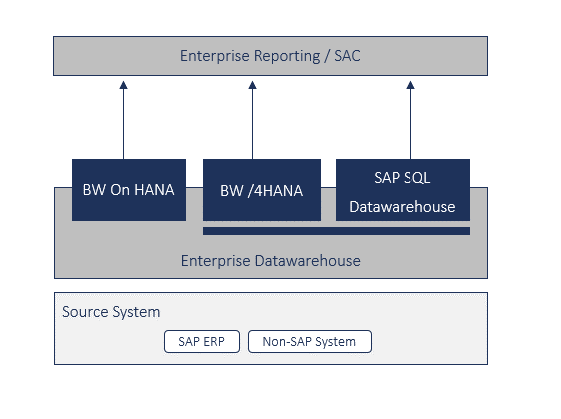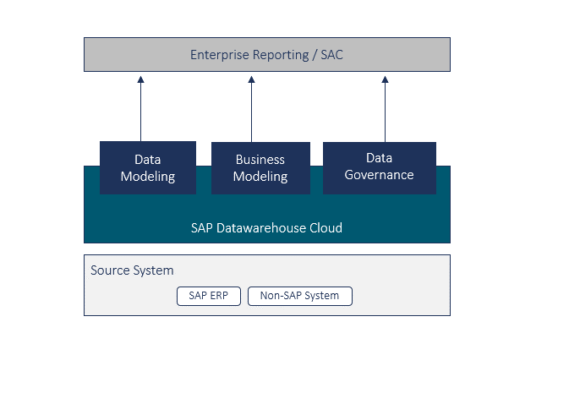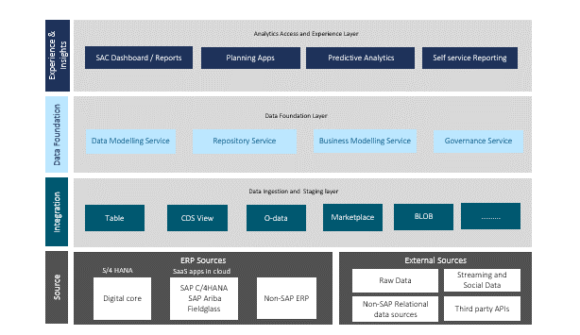In today’s data-driven world, all enterprises need to integrate data action nodes for their strategic and operations decision. To enable data-driven decision, the important criteria is to extract value from structure/unstructured data with continuously increasing data volume and utilize this information (derived by data) on time via Business and IT handshaking. Integration of cloud strategy for enterprise reporting can bring IT and business together as a best course.
SAP Data Warehouse Cloud with its frontend tool SAP Analytics Cloud is the future of cloud-based solutions in the data warehouse area. Easy data integration, scalability, security, and no maintenance cost are the key factor to adapt the data warehouse landscape towards cloud technology.
As per the current situation with a customer’s existing system landscape, the main question is:
Is It Feasible to Replace the Existing Enterprise Data Warehouse System with SAP Data Warehouse Cloud?
As we all know, the existing Enterprise Data Warehouse (EDW) system was built with continuous efforts over the last 10 to 15 years. Many customers started their enterprise data warehouse journey with SAP BW and updated their system as per new release for example BW 7.x, Bw7.5, BW on HANA and BW4HANA.
Due to this, the justification of the future data warehouse system can be explained via various aspects:
Major Pain Points of Existing System Landscapes
For all SAP-centric customers, EDW system architecture includes either SAP BW on HANA, SAP BW or BW4HANA, which is a very stable and mature product from SAP. SAP BW as product has a very large customer base and has seen huge investments from SAP and customers. So, in my opinion BW or BW4HANA will not end in the near future.

But if we talk about data-driven enterprise and their pain points, some are clearly visible and need proper attention, as for example:
- lack of efficiency to utilize multiple spreadsheets for data analysis,
- no self-service data access for business users,
- limited possibility for real-time analytics,
- long IT lead times (up to 2 months) for data,
- hybrid solution needed to combine the cloud with on-premises investments.
To overcome the traditionally known problems and gain a clear visibility of future data-driven enterprise, SAP DWC offers following key aspects:
- easy data integration with simplified web user interface
- business user empowerment, can now connect with data model, and visualize data
- real time analytics with live connection between DWC and SAC
- Cloud strategy of companies to move entire data warehouse as service
- data governance as a service
- flexible and simplified package pricing
- modern cloud solution with advanced analytics capability (ML and AI integration)

Vision or Strategy from Organization
For many customers, a cloud platform is clearly identified as the future path for all data-driven activities. In that case, SAP DWC is the best fit and it will tightly integrate all existing SAP Tools available in market.
Available EDW Scenario for the Near Future
EDW scenarios can be categorized according to the following features: sizing of system, business function or processes included, available source systems, and the scope of external data integration.
For example, flexible pricing will provide an opportunity to achieve a cost-effective solution to start with minimum database size and expand it in the future as needed. Our suggestion is to use advanced analytics using SAP Analytics Cloud, which comes embedded into SAP DWC.
Business function and processes explain the nature of a dataset involved (structured/unstructured or streaming data) and play a major role to identify the right Data Warehouse platform to provide seamless data integration without any data redundancy.
New requirements in pipeline include innovation topis, data usability and real time data availability up to certain extend. All new requirements in the pipeline are highly dependent on tool capability. For instance, a single field change in a report via a SAP BW change management process can take up to a 3 to 4-weeks to complete while in DWC, the same task can completely shift to business-modeling-as-a-service, so the user can adjust it on their own.
An analysis of given components can easily provide a direction for the customer towards a future EDW system landscape.
Next to these benefits, SAP DWC offers other important features as a data warehouse solution. They help to ensure the right path for future EDW system components.
- simplify and accelerate analytics,
- highly scalable and no system maintenance effort,
- cloud strategy of companies to move the entire data warehouse as service,
- business users can now connect, model, and visualize data,
- real time analytics with live connection between DWC and SAC,
- ability to create scalable models that can be reused multiple times,
- modern cloud solution with advanced analytics capability (ML and AI integration),
- easy data integration with simplified web user interface, wide range of standard data connection for structured/unstructured and streaming data,
- on-premises data source seamlessly connects with SAP Data Warehouse Cloud, without replication,
- data governance & space management provide more freedom to department and centralized data management to IT,
- pre-built content and tightly integrated with all SAP products.
Regarding the high-level architecture of an enterprise data warehouse including SAP DWC can be categorized with different layers as per available component and their function.

The data integration layer offers a scenario-based data connection for data provisioning and includes data connection via APIs for structured, unstructured, streaming, and open-source data. Data transformation and enrichment as per business need is governed by the data foundation layer. Data governance and a business modeling service are key components to fill the gap between IT and business users.
Integrated Approach towards a Next Generation Enterprise Data Warehouse
The SAP data warehouse cloud powered by SAP HANA Cloud services is an integrated approach to offer enterprises an end-to-end data management and decision-making cloud solution. It is a scalable, open, and persona-driven warehouse as-a-service solution, suitable for SAP and non-SAP customers, offering reduced deployment complexity, optimized/flexible pricing with integration to SAP Business Technology Platform, SAP Analytics Cloud, Partner solutions and open-source technologies. SAP DWC & SAC provide the possibility for a green field implementation to integrate data from all types of heterogeneous sources in one place and avoid unnecessary data movements, analyze data in remote sources for faster outcomes, less data preparation times and rapid prototyping via Dev/QA and Prod space concept. Embedded DI data flow, Python and Data marketplace provide a tremendous opportunity to integrate the external unstructured data with enterprise data and support a advance predictive planning application via external factor integration. Direct integration with SAP Analytics Cloud enriches the Analytics property and business user involvement.
Overall DWC and SAC is a complete package to fulfill all enterprise reporting needed in an easy way with ideal collaboration conditions between IT & Business. The latest SAP announcements about BW Bridge provide the opportunity to combine the old system landscape and start journey towards Cloud Data Warehouse Platform.

